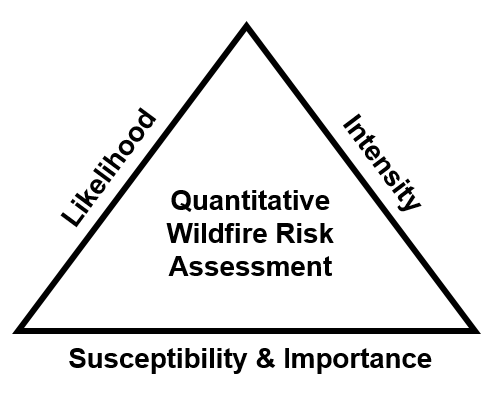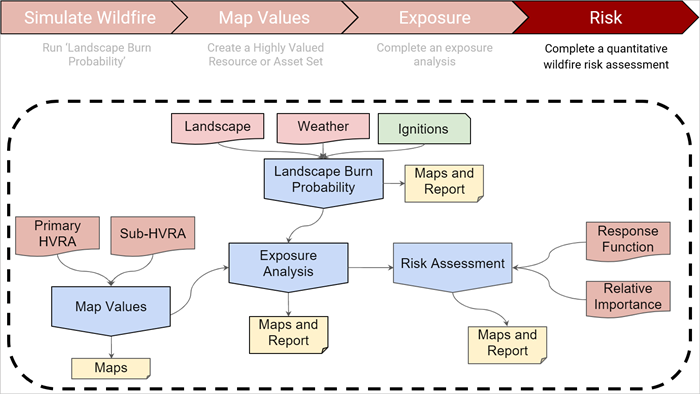About Quantitative Wildfire Risk Assessment (QWRA)
Why Conduct a QWRA
Conducting a Quantitative Wildfire Risk Assessment (QWRA) can make land management decisions more effective by characterizing the predicted benefits and threats from fire on several, often overlapping, values across your landscape. This information can be used to plan fuel treatments, pre-plan suppression response, design fire effects monitoring programs, and other related management activities on a landscape while accounting for the predicted benefits and threats from fire and the relative importance of different landscape values.
Definition
The "Risk Assessment” encompasses both threats and benefits from fire. Some resources may benefit from fire occurrence (i.e. fire dependent plant species) while others may be threatened (i.e. infrastructure).
QWRA represents both losses and benefits resulting from fire and takes into account:
- How often fire occurs (Likelihood)
- The intensity when a fire occurs (Intensity)
- The effects of fire on HVRAs (Susceptibility) & their importance (Importance)

Overview
The Risk Assessment task in the IFTDSS Planning Cycle is the final stage of the Quantitative Wildfire Risk Assessment (QWRA) process. The entire process includes landscape creation and/or editing, modeling landscape burn probability, defining and evaluating highly valued resources or assets (HVRAs) and finally running a QWRA in order to evaluate the net threat or benefit of fire on a given landscape.
Specifically, the QWRA interface relies on previous completion of the following in IFTDSS in order to be run:
Each of the above is included in the Risk Assessment workflow illustrated below.

Inputs
QWRA is initiated by first selecting a completed Exposure Analysis (EA). In IFTDSS, the EA contains all the necessary Landscape Burn Probability information and Highly Valued Resource or Asset (HVRA) information required for QWRA.
Once the Exposure Analysis is completed the next step is to quantify and prioritize Response Functions and Relative Importance:
- Response Function: The susceptibility or response of a Sub-HVRA to wildfire. Response functions are expert-defined and translate fire effects into value change (-100 to +100), based upon fire intensity. (GTR-315)
- Relative Importance: A quantitative weight used to differentiate importance of HVRAs. This is required when more than one Sub-HVRA is present. Relative importance weights are on a scale from least important to most important (1 to 100). Relative importance should reflect fire management objectives and priorities. (GTR-315)
Outputs
Outputs for QWRA focus on Net Value Change (NVC), the overall change in value (positive/benefit or negative/threat) on a given pixel, factoring in Landscape Burn Probability outputs and HVRA locations along with response functions you specify, and your inputs for the relative importance of each HVRA. In IFTDSS, two NVC values are available:
- Conditional Weighted NVC: A product of fire Intensity, susceptibility, and importance.
- Expected Weighted NVC: A product of Conditional NVC and burn probability.
See the QWRA tutorial for step by step instructions on running QWRA
Additional Resources to Learn About the Risk Assessment Process
- Scott, Joe H.; Thompson Matthew P.; Calkin, David E. (2013) A Wildfire Risk Assessment Framework for Land and Resource Management. General Technical Report RMRS-GTR-315. USDA Forest Service, Rocky Mountain Research Station, 83 p.
-
USDA Wildfire Risk Management Science Team website : Several risk publications as well as projects and tools.
-
Pyrologix Publications Page : Most of the listed publications address risk assessment or burn probability.

